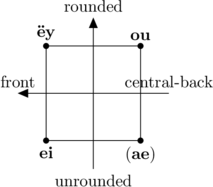


| ||||||||||||||||||||||||||||||||||||||||||||||||
Phonotactical restriction include:
Anaptyxis in consonant clusters:
Positional change of s to h:
There is a twofold lenis-fortis distinction:
Stress:
|
The diphthongs can be represented in a neat little diagram. Kymna only employs ’homorganic’ diphthongs:

Hostorically, the mid long vowels [ε:, œ:, ɔ:] broke into ei, ëy, ou [εı̯, œy̯, ɔu̯], wherefore long variants of e, ë do not appear in the language, although long ō has been recreated by other changes. The diphthong ae [aæ̯]∼[ɑʌ̯] only appears in Moluma where it is the result of long [a:]∼[ɑ:].

